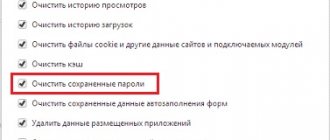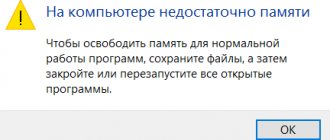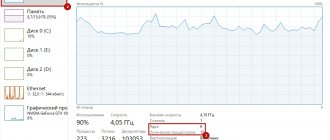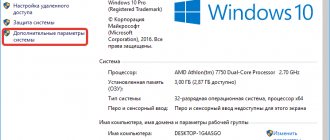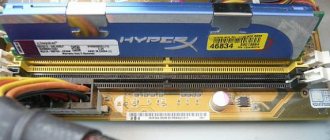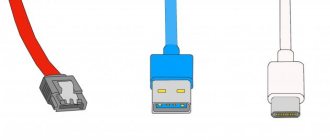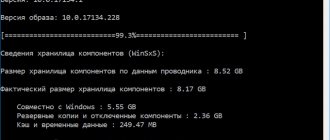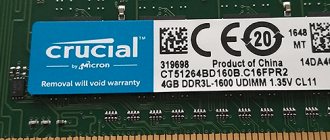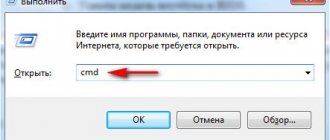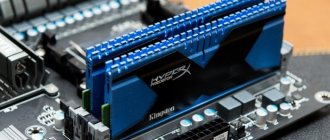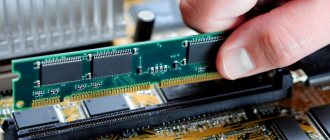There is an opinion among computer users that you can never have too much RAM... And you can’t argue with this, dear reader, especially when it comes to modern machines whose hardware configuration corresponds to solid characteristics, and the Windows system installed on board the PC is 64 -bit version. However, the “painful” problem of many - “the computer’s physical memory is loaded, what should I do” - still continues its inglorious existence, perplexing the average user and sometimes forcing an experienced computer guru to rack his brains over solving the “lack of RAM” problem. However, we will not delve into the extreme complexity of “operational misunderstandings” and will resort to simple, but nevertheless effective methods for diagnosing and optimizing the computer swap system. Well, the article promises to be memorable. RAM secrets are waiting to be revealed!
Guard, the computer's physical memory is loaded!
What to do and how to deal with it? Probably, these are the questions that come to the user’s mind when he becomes an involuntary witness to the monstrous slowness of the Windows operating system.
- With each subsequent turn on of the PC, the startup of the OS becomes slower and slower.
- The clickability of the operating system at startup and during use becomes unbearable due to the “long-lasting waiting process.”
- The once “flying” applications, to put it mildly, take a long time to start.
- Incomprehensible service messages attack the monitor with their “unobtrusive” presence.
In general, any of the above scenarios (not to mention their complex manifestations) can quickly drive any user crazy. But not everyone who is “expecting” understands that everything described above may be the result of our own omissions. And it’s unlikely that the average user even knows how to make sure that the computer’s physical memory is loaded?
Determining what loads physical memory?
When faced with a similar situation, the first thing you need to do is determine the culprit and find out which program or process consumes the most memory.
To do this, open the task manager by right-clicking on the taskbar and selecting “Task Manager” from the menu that opens.
Launching Task Manager
In it, go to the processes tab and, if available, check the “Display processes of all users” checkbox.
Processes tab in Task Manager with process sorting enabled to reduce memory consumption
Next, we sort the list of running processes in descending order of consumed physical memory by clicking on the name of the “Memory” column.
Now you can clearly see which program consumes the most memory.
Very often in Windows 7, almost all of the physical memory is consumed by the svchost.exe process. If this is what is eating up all your RAM, then we recommend that you read this article.
In all other cases, simply highlight the process that is consuming a large amount of RAM and click the "End Process" button.
It is also worth checking the startup list and eliminating from it all unnecessary programs that automatically load along with the operating system and take up space in the computer’s physical memory.
For comfortable work at the computer in operating systems Windows 7 and higher
There is an opinion among computer users that you can never have too much RAM... And you can’t argue with this, dear reader, especially when it comes to modern machines whose hardware configuration corresponds to solid characteristics, and the Windows system installed on board the PC is 64 -bit version. However, the “painful” problem of many – “the computer’s physical memory is loaded, what should I do” – still continues its inglorious existence, perplexing the average user and sometimes forcing an experienced computer guru to rack his brains over solving the “lack of RAM” problem. However, we will not delve into the extreme complexity of “operational misunderstandings” and will resort to simple, but nevertheless effective methods for diagnosing and optimizing the computer swap system. Well, the article promises to be memorable. RAM secrets are waiting to be revealed!
What should you do first if your PC loses performance?
Of course, first of all, you need to diagnose the system. Moreover, everything necessary for this is provided in advance by Microsoft developers. Well, it's time to move on to the practical part of our story.
- Right-click on the taskbar (the lowest area of the screen).
- From the drop-down list, select “Manager...”.
- Once in the work area of the service window of the same name, use the “Performance” tab.
- A visually presented graph will allow you to estimate the RAM utilization rate. If Vista or a later version of Windows OS is installed on your PC, then the value of memory used should not exceed 70-75% of the total nominal value of the physical swap. Otherwise, you need to unload the RAM area.
How to reduce RAM usage? How to clear RAM
Hello.
When too many programs are launched on a PC, the RAM may no longer be enough and the computer will begin to slow down. To prevent this from happening, it is recommended to clear the RAM before opening “large” applications (games, video editors, graphics). It would also be a good idea to do a little cleaning and tuning of applications to disable all little-used programs.
By the way, this article will be especially relevant for those who have to work on computers with a small amount of RAM (usually no more than 1-2 GB). On such PCs, the lack of RAM is felt, as they say, “by eye”.
1. How to reduce RAM usage (Windows 7, 
In Windows 7, one function appeared that stores in the computer's RAM memory (in addition to information about running programs, libraries, processes, etc.) information about each program that the user could launch (in order to speed up work, of course). This function is called Superfetch .
If there is not a lot of memory on the computer (no more than 2 GB), then this function, most often, does not speed up work, but rather slows it down. Therefore, in this case it is recommended to disable it.
How to disable Superfetch
1) Go to the Windows Control Panel and go to the “System and Security” section.
2) Next, open the “Administration” section and go to the list of services (see Fig. 1).
Rice. 1. Administration -> services
3) In the list of services we find the one we need (in this case Superfetch), open it and put it in the “startup type” column - disabled, additionally disable it. Next, save the settings and restart the PC.
Rice. 2. stop the superfetch service
After you restart your computer, your RAM usage should decrease. On average, it helps reduce RAM usage by 100-300 MB (not much, but not so little with 1-2 GB of RAM).
2. How to free up RAM
Many users don’t even know what programs “eat up” the computer’s RAM. Before launching “large” applications, in order to reduce the number of brakes, it is recommended to close some programs that are not needed at the moment.
By the way, many programs, even if you closed them, can be located in the PC’s RAM!
To view all processes and programs in RAM, it is recommended to open the task manager (you can also use the process explorer utility).
To do this, press the CTRL+SHIFT+ESC buttons.
Next, you need to open the “Processes” tab and remove tasks from those programs that take up a lot of memory and that you do not need (see Fig. 3).
Rice. 3. Cancel a task
By the way, the “Explorer” system process often takes up a lot of memory (many novice users do not restart it, since everything from the desktop disappears and they have to restart the PC).
Meanwhile, restarting Explorer is quite simple. First, remove the task from the “Explorer” - as a result, you will have a “blank screen” and a task manager on your monitor (see Fig. 4). After this, click “file/new task” in the task manager and write the command “explorer” (see Fig. 5), press the Enter key.
Explorer will be restarted!
Rice. 4. Closing Explorer is easy!
Rice. 5. Launch explorer/conductor
3. Programs for quickly cleaning RAM
1) Advance System Care
More details (description + download link):
An excellent utility not only for cleaning and optimizing Windows, but also for monitoring your computer's RAM. After installing the program, there will be a small window in the upper right corner (see Fig. 6) in which you can monitor the load on the processor, RAM, and network. There is also a button to quickly clear RAM - very convenient!
Rice. 6. Advance System Care
2) Mem Reduct
Official website: https://www.henrypp.org/product/memreduct
An excellent little utility that will highlight a small icon next to the clock in the tray and show what % of memory is occupied. You can clear RAM in one click - to do this, you need to open the main program window and click on the “Clear memory” button (see Fig. 7).
By the way, the program is small in size (~300 KB), supports the Russian language, is free, and has a portable version that does not require installation. In general, it’s hard to imagine anything better!
Rice. 7. Clearing memory in mem reduct
PS
That's all for me. I hope these simple steps will help you make your PC work faster.
